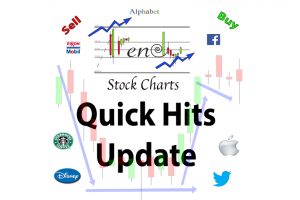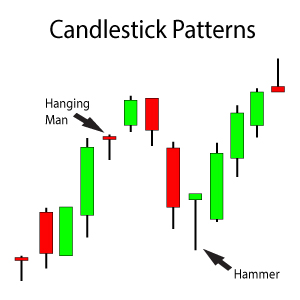I apologize for the lack of articles the last week. A few articles should be out today. I have been mostly bed-ridden with lower back pains and had a MRI yesterday after my insurance finally approved it. The pain drugs are kicking in and I can move around again at least. So far this morning I can sit without pain…so let’s roll….
Two weeks ago on July 25, 2017, Advanced Micro Devices (AMD) reported earnings. That evening, I posted a chart in the Idea Chamber talking of another double for AMD’s share price over the next year. What happens next? Of course AMD sells off for the next two weeks. I usually don’t comment on a stock’s earnings movement until it has had a full day of trading. I wish I would have abided by my own rules and waited before making that comment. I did purchase shares the next day myself and have been underwater since.
This Advanced Micro Devices (AMD) post-earnings chart review and analysis will dive into the details of the “double” that I spoke of in the next year. Is it time to purchase more shares or time to bail on the trade? It’s time to take a closer look and review Advanced Micro Devices (AMD) post-earnings sell-off.
Advanced Micro Devices (AMD) Post-Earnings Analysis
This first chart in this Advanced Micro Devices (AMD) post-earnings analysis is a 1 year daily candlestick chart. The chart has my typical 5 different simple moving averages overlaid on it. The $11.75 price level is a key area to hold from a moving average perspective. Any breach of that area on heavier than normal selling volume is a bearish sign.
This next week or activity for AMD should be very telling. If AMD continues its sell-off and [s2If !current_user_can(access_s2member_level1)]……
If you want to continue reading this Advanced Micro Devices (AMD) post-earnings stock chart analysis, you must first login.
Support areas for AMD’s share price are reviewed as well as trading ideas based off of the support areas.
If you are not a Trendy Stock Charts member, consider joining today! There are several different subscription plans available.[/s2If][s2If current_user_can(access_s2member_level1)]breaks below the 200 Day moving average on selling volume that is higher than normal trading volume, then anticipate lower prices still for its share price.
However, if AMD can hold the $11.75 price level, a rebound should then commence. The strength of the rebound would then be monitored to see if AMD is going to make another 52 week high. Moving back above the 50 Day moving average on above average buying volume would be one indicator that a new 52 week high could be coming.
If AMD’s share price fails to make a new high on its attempted rebound, consider selling some shares into strength after it flashes some bearish signals. One more pullback is anticipated after a new high and before the next significant rally takes place.
AMD – 5 Year Monthly
This next chart is a 5 year monthly candlestick chart for Advanced Micro Devices (AMD). I want to analyze AMD’s longer-term trend and make sure that is intact first. One of the key components to analyze the trend is using the MACD Histogram on your charts like I have on this one.
The MACD Histogram shows buying momentum. But that buying momentum is decreasing at the current moment. As long as there is buying momentum though, AMD’s share price should see a rebound that reaches towards its previous highs.
The MACD Histogram on AMD’s daily chart (not included here) actually reflects increasing selling momentum at the current moment. Increasing selling momentum on a daily chart indicates probable lower prices in the near-term. Could that be indicating further weakness towards the $9.50 area? When shorter-term and longer-term charts do not agree, I tend to look more at the longer-term signals than the shorter-term.
20 Year Monthly Chart
Let’s step back and take a peek at the 20 year monthly chart also for AMD. The main reason is to look at its overhead resistance from the longest-term perspective that Think or Swim will allow me – a 20 year view. The buying volume during the recent uptrend has been enormous.
Reaching its overhead resistance area is going to involve some additional catalysts. Lack of these catalysts and AMD will have difficulty. The first part of this uptrend took approximately a year to unfold. The next part of the uptrend, whenever and if that begins, will probably look something similar.
The above 20 year monthly candlestick chart shows that AMD is about half way towards its overhead trendline resistance area. Maybe some additional consolidation is needed here before the next leg up continues. Additional consolidation means possible lower share prices though.
Long-term though, the question to ask yourself is this – will the computer chip industry continue its strength? If you think so, AMD appears to have some nice long-term potential. Especially if you can pick up some shares on any continued pullback towards the $9.50 area.
I wish I wasn’t so quick to purchase a few shares right after earnings. I will purchase more if it does continue pulling back to the $9.50 area. And I may consider trimming some shares if its share price rebounds from its current price.
AMD – P&F Charts
What do the Point & Figure charts say about Advanced Micro Devices (AMD) post-earnings share price activity? Well, the P&F Charts read like a Charles Dickens novel called “A Tale of 2 Cities”.
The P&F Charts are split with bearish and bullish results. The Closing P&F Chart reflects a bullish price objective of $17.75; the High/Low P&F Chart reflects a bearish price objective of $9. AMD’s share price closed at $12.23 on Friday.
Advanced Micro Devices (AMD) Post-Earnings Summary
Based on the mixed results from the Advanced Micro Devices (AMD) post-earnings analysis, shorter-term investors are best advised to put AMD on a watch list. Set an alert if AMD’s share price drops below the $10 price level. Start looking for bullish reversal signs at that time and for the next couple of days.
Longer-term investors could consider a small scale-in purchase around or slightly above the $11.75 area if the support area holds over the next couple of days or starts to rebound with strong buying volume as monitored on a daily chart. In the event of a further pull-back, keep cash for another scale-in purchase around the $9.50 – $10 price area. Shorter-term investors should start paying attention in this area too.
As always, ask away with any questions now or as the trade develops. Good luck trading!
[/s2If]

















Ask a Question. Make a Comment. Leave a Reply.